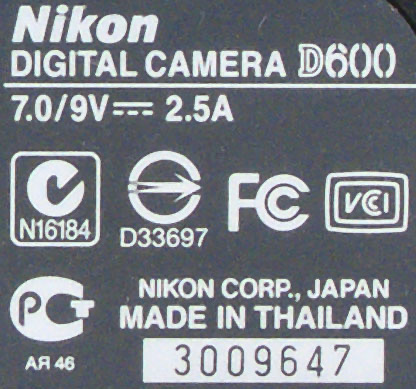
Nikon for a long time used the first digit of the serial number to indicate region for many of their products (all the way back into the film SLR era). Traditionally, that first digit was used by Nikon like this:
- Not used
- Japan
- USA
- Europe (excluding UK)
- Canada
- Australia/New Zealand
- Asia (excluding Japan)
- United Kingdom
- Not used
Don’t get locked into those values, though (read on for recent exceptions).
Initial production of a product was almost always a two-digit variant of that with the second digit being zero (e.g. 30xxxxx in the US). In a few cases, Nikon has used digits outside a region when production exceeds 999,999 units (see Note in next paragraph, though). That's why the second digit isn't just part of the serial number itself: it’s also reserved as a special region indicator, when needed. In other words, while US products normally would be 30, 31, 32…39 in initial numbers, Nikon set things up so that they could make, say, a 25 region code that's US for a product (normally that would be Japan).
Note: Nikon never changed the number of digits in most product serial numbers, which as product quantities increased during the early digital age, caused Nikon to have to abandon the clear logic they formerly used and which the above table suggests.
It appears that Nikon has adjusted many of their previous serial numbers to give them plenty of room for US, Asian/Pacific, and European bodies. For example, with the D7100, Nikon started using the 25xxxxx code for the first US bodies. Since the US D7100 number comes after the initial number for the smaller Japanese market, it makes some sense to "steal" some of the Japan numbers for the larger US volume. But also oddly, we’re now seeing that a lot of other country serial numbers don't tend to have a 0 as a second digit, which is another departure for Nikon.
As I keep updating this article, Nikon continues shifting to a very problematic (for customers) method of uniquely identifying region, especially in Europe, where they’ve also used previously Canadian and Australian numbers (e.g. 51xxxxx and 61xxxxx), and in the Asia/Pacific, market where they now often use 6xxxxxx, 7xxxxxx, and 8xxxxxx numbers.
A few products, most notably the low volume top end pro cameras, use only the Japan-based serial numbers. Thus, you can have a D3 with a 20xxxxx serial number no matter where in the world you bought it (curiously, the D5 reverted back to the regional numbering system).
The same scheme often applies to lenses, though most recent US DSLR lenses are prefaced with the letters US and some recent lenses have longer serial numbers.
So where we stand is this: older gear clearly follows the original numbering practice in the table shown at the top of this page. The latest gear is much more complicated in how serial numbers are used. That said, a serial number with 0 as the second digit is almost always allocated according to the table, above.
As I noted two decades ago, Nikon really just needs to abandon this serialization practice. The primary reason it’s done is to enable Nikon to identify gray market cameras and deny warranty and repairs on them. In essence, Nikon’s trying to act like as series of local companies in a global environment.
